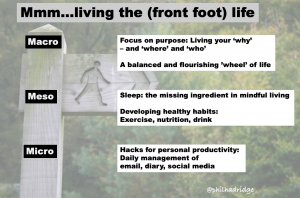I enjoy coaching clients. I am doing more of it. I describe my role as being a bit of a sounding board.
It might be a GP looking to achieve personal goals in the context of a complex set of practice relationships. It might be a manager thinking how they can live a more balanced life. It might be a fashion specialist wanting to develop the skills to have greater impact. These ‘coachee’ clients are keen to stop and examine how far they are living the sort of life they want. Are they on the front foot?
Regularly we end up exploring the three main areas where improvement is possible. Are these useful prompts for you?
First, the ‘macro’. Are you doing the sort of work that you want? Are you playing to your strengths – and interests. There is a load of stuff online to help you examine your life purpose: your ‘why’. Have a look for Simon Sinek if you don’t know where to start.
How are you doing in achieving progress in the most important domains for you. Are you flourishing? Have you ever completed a ‘wheel of life’. How are you doing with maximising the size and smoothness of the circle? Do you need a career change? Or is some other big choice likely to help you?
Second, the ‘micro’. Are you in charge of your work or is it determining you and your choices? There are load of hacks and apps to help you manage the demands for your time, and we have contributed to the burgeoning resources for personal productivity. Many of the ideas are quite simple but do take some discipline. For example, blocking chunks of time in your diary or running a daily ‘to do’ list or keeping an empty inbox by rapidly triaging emails and building a ‘for action’ folder.
However, thirdly, is the ‘meso’, in the middle as the image below shows. I think this is particularly useful. The importance of developing a positive relationship with food and helpful exercise routines is well known. I promote some ideas for LADish drinking.

Despite recent coverage an area with huge potential for improvement at this meso level for most of us is sleep. I meet people who are working to become mindful through mediation but who are short cutting their sleep every night due to domestic pressures or Netflix box sets. There is a burgeoning research into the importance of a good nights sleep and many tips for the things we can do to achieve it. For me going to bed early is key so any period of wakefulness and restlessness doesn’t really matter. We literally don’t have to have our backs (of our minds) against the clock.
So, how is that? Macros, Meso, Micro. How can you edit your life so you are on the front foot?
So, you can you pause and say: “mmm…I am living the life I want”
